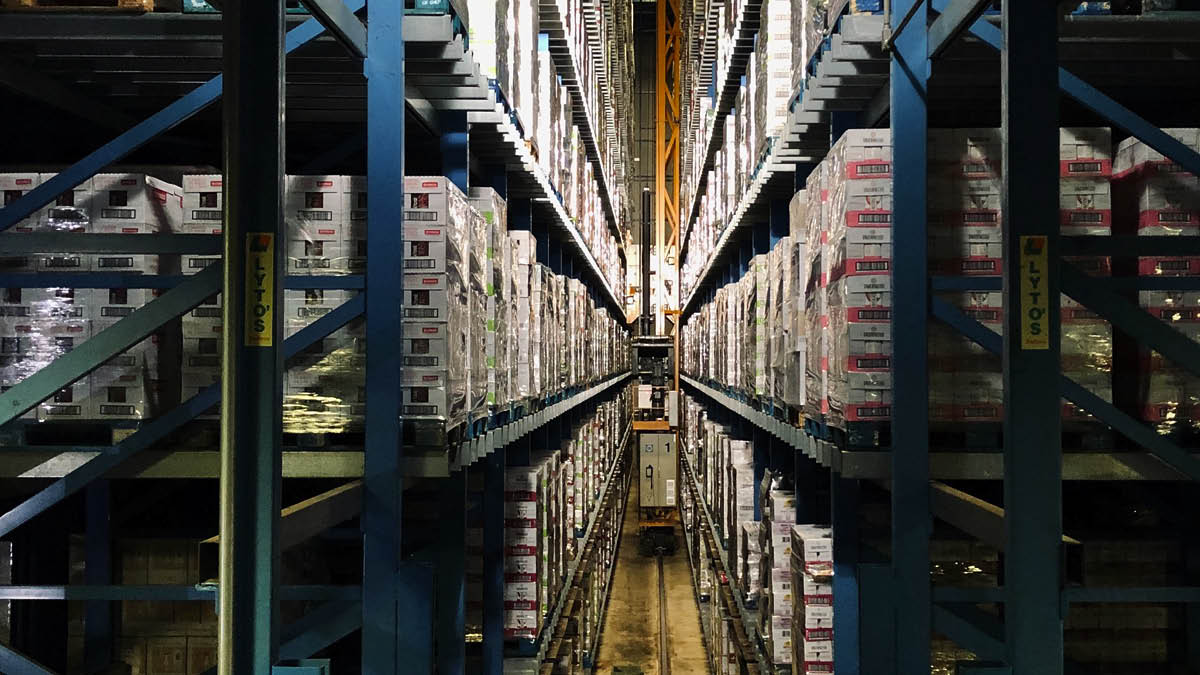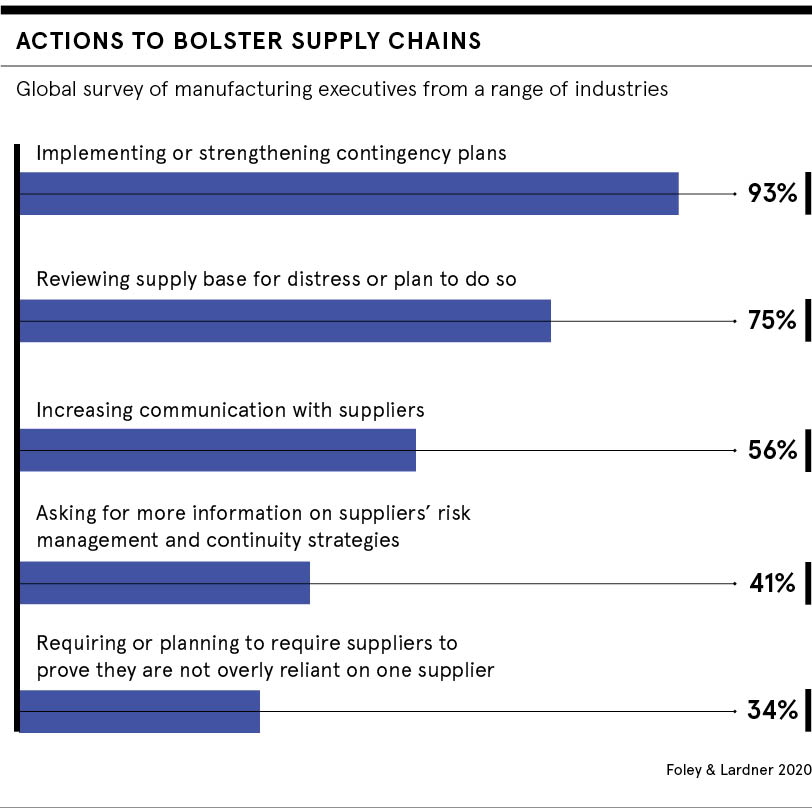
Coronavirus has sent shockwaves through the world’s supply chains. As countries locked down and travel restrictions kicked in, there was a rush to find new suppliers and plug gaps that were starting to appear. Procurement managers took unprecedented risks to keep the show on the road and supply chains, which previously had been rigorously managed, began to fray at the edges.
“In early-lockdown, the need to react swiftly outweighed the risks of a streamlined due-diligence process,” explains Paul Massey, product director at management company Proactis. “There simply wasn’t the time for laborious processes of any kind; all parts of the supply chain management process were accelerated. If you were lucky, the gaps were then filled in retrospectively, but in many cases the risks were simply accepted.”
Now, as businesses start to get to grips with the “new normal”, COVID-19 has forced many to critically re-examine their supply chain structure and future procurement strategy.
Giving supply chains a strategic edge
“What the pandemic has caused is a need for information,” says Nicole DeHoratius, professor of operations management at Chicago Booth School of Business, which recently opened a campus in London. Alongside issues such as capacity, buyers need financial information, too. Now, rather than a simple box-ticking exercise, buyers are starting to mine down to get a real sense of how viable their suppliers are, she says, and whether they’re overstretching themselves.
Chris Laws, head of product and strategy at Dun & Bradstreet, sees the buyer-supplier relationship as a balancing act, with speed on one side, risk on the other. At the moment, he fears: “We’re seeing it tip so far towards ‘do it fast, do it now,’ and ignoring the risk policy, and that’s going to cause a problem.”
Health and safety issues, human trafficking, exploitation, modern slavery: “they’re the type of things that we are at risk of missing when we go too fast”, says Laws.
Building a supplier map can help bring much greater visibility and resilience to a supply chain, he says. Just knowing who your direct suppliers are is no longer enough.
The buyer-supplier relationship is a balancing act, with speed on one side, risk on the other
Ben Collett, managing director of risk specialists Duff & Phelps, says: “Investment in technology and information flow allows greater visibility and communication through a tiered supply chain. It may not be your direct supplier that is the source of a supply failure, but their supplier or a supplier to that sub-supplier.”
Harnessing the power of data
Data and digitalisation are also set to have a major impact, says Laws. “While data has always been part of the supply risk assessment, it was typically only used as an efficiency play, rather than an operational necessity,” he says.
Now businesses can leverage data and analytics to uncover suspicious activity. Mapping out business relationships and untangling large volumes of data can develop an accurate view of supply chain activities.
Laws also believes the pandemic will drive a major shift in digitalisation. “A lot of supply chains are still paper based,” he says, but with so many people now working from home, the flaws in relying on scanned documents and a precarious paper trail are easy to see.
Alex Saric, smart procurement expert at procurement software company Ivalua, agrees that technology holds some of the answers. “The key is to be able to access all relevant information on suppliers and be able to have a holistic view,” he says.
The next step for this approach is greater collaboration. “As organisations struggle to ensure supply continuity, manage cash and protect the bottom line, they’re realising the importance of working closely with suppliers that themselves are struggling with these issues,” Saric adds.
“This has hastened the shift in supplier relationships away from being transactional and cost focused, to ones that promote collaboration and working together on innovation and mitigating the impact of events like COVID-19.”
DeHoratius at Chicago Booth School of Business says: “Supply chains have always over-emphasised cost at the expense of resilience.” While flipping this may involve spending more on building relationships and creating a supply chain that’s responsive and flexible at the outset, the trade-off will be worth it, should another disruption occur, she explains.

The importance of expanding the supply chain
Another trend designed to reduce risks is the shift to multi-sourcing, as many companies that relied on a single source for components were found out at the start of the pandemic.
“We have seen buyers expanding supplier networks to make them more robust, which spreads risk,” says Massey of Proactis. “This is particularly pertinent when geography is a factor; many have retrenched from the global supply chain and are seeking options much closer to home.”
He has also seen an increase in vertical integration, with large corporates buying up elements of the supply chain, as they shun outsourcing to bring capabilities back in-house.
While the start of the pandemic saw many companies taking exceptional risks to fill gaps in their supply chains, many will now be better prepared for further disruptions. For Massey, this means due diligence and relationship-building will soon be back as constants in supply chain management.
“However, there is now a real need for organisations to put processes and technology in place that make supplier sourcing and onboarding as quick and painless as possible,” he concludes.
Five tips for choosing suppliers in the new climate
1 Get technical
More companies are investing in technology to gain the visibility and insight they need to act quickly. Creating a register of all suppliers can help a business react to swings in demand or disruptions such as the coronavirus pandemic. “Just knowing geographically where a supplier is based is crucial, because you never know where the next lockdown is going to happen,” says Chris Laws of Dun & Bradstreet.
2 Don’t focus on cost alone
Over-reliance on practices designed to reduce costs has left many businesses with few options when traditional supply chains are disrupted. Reliability and security of supply should now be seen as far more important than price.
3 Multi-source
Using multiple suppliers helps to build resilience by reducing risk and the potential for operations to be disrupted. Trust through association is another powerful approach, and networks of companies are starting to pool resources and work together.
4 New partnerships
Current disruption has reinforced the need for buyers and suppliers to collaborate. Penalties may be an incentive to ensure great service, but when businesses are struggling, they can backfire; far better to collaborate instead.
5 Don’t forsake due diligence
Due diligence when selecting new suppliers is as critical now as it has ever been. Organisations need to be confident a supplier doesn’t pose a risk to their reputation or the efficiency of their supply chain.
